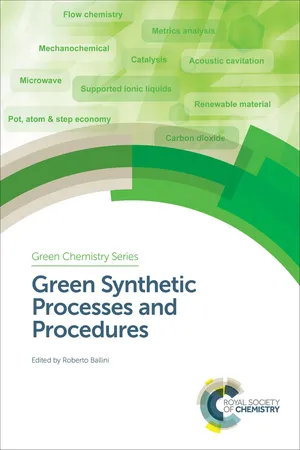
Green Synthetic Processes and Procedures
Roberto Ballini, Roberto Ballini
- 413 páginas
- English
- ePUB (apto para móviles)
- Disponible en iOS y Android
Green Synthetic Processes and Procedures
Roberto Ballini, Roberto Ballini
Información del libro
The principles of Green Chemistry aim to improve the sustainability of chemical processes and reduce the generation of hazardous substances. There has been great growth in the field over the past few years and the number of research groups working in this area is still increasing. Now one of the biggest challenges is to embed the Green Chemistry ideals of safety and sustainability as standard, both in industry and academia. In order to do this, it is important to create resources that detail different applications and approaches.
Green Synthetic Processes and Procedures brings together expert contributors from across a number of areas of green synthesis to cover a diverse array of subjects. Providing a thorough overview of the current green synthetic toolbox, from biocatalysis to sonochemistry, this book is a useful resource for any chemist wishing to design cleaner and safer processes.
Preguntas frecuentes
Información
*E-mail: [email protected]
Although the ecological footprint was perhaps the first green metric, the atom economy and E-factor have become the key metrics of green chemistry by providing the mass balance of chemical reactions and processes at the molecular level. Sustainability was poorly defined originally, since the key requisite to accurately forecast the needs of future generations remains difficult to pinpoint. Consequently, sustainability was replaced with suitability by many stake holders, as they had vested and/or conflicts of interests to label suitable developments sustainable. The sustainable development goals recently introduced by the United Nations seem to serve as a ‘roadmap to happiness’ instead of metrics. A simple and independent definition of sustainability was recently provided: Nature's resources, including energy, should be used at a rate at which they can be replaced naturally, and the generation of wastes cannot be faster than the rate of their remediation by Nature. The ethanol equivalent, the sustainability values of resource replacement and fate of waste, and the sustainability indicator have been recently defined to measure the sustainability of biomass-based carbon-chemicals and renewable energy. The production of ethylene, propylene, toluene, xylenes, styrene, and ethylene oxides cannot be sustainable due to the limited amount of bioethanol. The required volume of corn and the corresponding size of land are only enough to replace one sixth of fossil resources in the USA, EU, and China, and practically insufficient in Canada and the Russian Federation. Until the utilization of electricity becomes practical and economical in aviation, biomass-based liquid fuels are the sustainable alternative.
1.1 Development and Definition of Green Chemistry
Box 1.1 The twelve principles of green chemistry 12
- It is better to prevent waste than to treat or clean up waste after it is formed.
- Synthetic methods should be designed to maximize the incorporation of all materials used in the process into the final product.
- Wherever practicable, synthetic methodologies should be designed to use and generate substances that process little or no toxicity to human health and the environment.
- Chemical products should be designed to preserve efficacy of function while reducing toxicity.
- The use of auxiliary substances (e.g., solvents, separation agents, etc.) should be made unnecessary wherever possible and, innocuous when used.
- Energy requirements should be recognized for their environmental and economic impacts and should be minimized. Synthetic methods should be conducted at ambient temperature and pressure.
- A raw material of feedstock should be renewable rather than depleting wherever technically and economically practicable.
- Unnecessary derivatization (blocking group, protection and deprotection, temporary modification of physical/chemical processes) should be avoided whenever possible.
- Catalysts (as selective as possible) are superior to reagents.
- Chemical products should be designed so that, at the end of their function, they d...